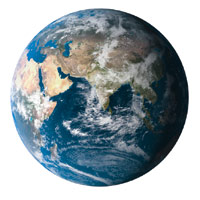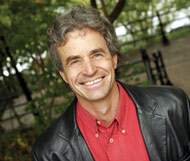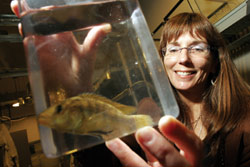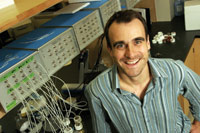The delicate balance of biodiversity
The delicate balance of biodiversity McGill University
User Tools (skip):
The delicate balance of biodiversity

At more than 100 kilograms, the Nile perch is a big fish even in a big pond. In the 1950s, the voracious predator showed up mysteriously in Africa’s Lake Victoria, the largest body of fresh water in the world. Likely introduced surreptitiously to support a flagging fishery industry, its population exploded in the 1980s. The result: an important export for fishermen from surrounding Uganda, Tanzania and Kenya and, simultaneously, the decline or demise of hundreds of native fish, including 200 to 300 species of cichlids found only in Lake Victoria.
The loss of these cichlids – small and versatile, with the largest brain-to-body ratio of any fish – stands as one of the most dramatic mass extinctions in recent history. Eventually, the perch population also declined, a consequence of being heavily fished while at the same time gobbling down much of the food the lake had to offer.
The Nile perch scenario poses some timely questions. Biodiversity, or the range of species in a given environment, has an effect on how that environment functions as a system (or, more precisely, as an ecosystem). But so far we know very little about how organisms interact in ecosystems. How and why do species prosper or decline? And why does it matter?
“There is growing recognition that the diversity of life on earth, including the variety of genes, species and ecosystems, is an irreplaceable natural heritage crucial to human well-being and sustainable development,” writes Michel Loreau, McGill professor of biology, in an article in a recent issue of the prestigious scientific journal Nature. “There is also clear scientific evidence that we are today on the verge of a major biodiversity crisis.”
Defining the Problem
The article, co-written with a Ghanaian colleague and signed by 19 top international scientists, recites ominous statistics to prove its case: 12% of bird species, 23% of mammals, 25% of conifers, 32% of amphibians and 52% of cycads (an ancient family of palm-like plants) are currently facing extinction. Climate change could conceivably lead to the disappearance of an additional 15% to 37% of species by 2055.
"We are on the verge of a major biodiversity crisis."McGill Biologist Michel Loreau
“Ecology is about interactions,” says Loreau, who joined McGill’s biology department in 2005 as the Canada Research Chair in Theoretical Community and Ecosystem Ecology. At the time, then-Dean of Science Alan Shaver heralded the new arrival as the “Wayne Gretzky of biodiversity research.” Like the hockey star, Loreau had clinched most of the top awards in his field. Now he’s building our knowledge of the relation between biodiversity and ecosystem functioning – and at increasingly larger spatial scales. After all, it is one thing to examine a model ecosystem within a square metre of laboratory culture, but quite another to understand the complexity of interactions in a square kilometre of forest or field.
Loreau’s accomplishments include showing that plant diversity in grasslands increases the yield of primary agricultural crops such as corn – a controversial finding, as received wisdom dictated a monoculture in which all interlopers were weeded out. He has researched what happens when herbivores like cows and goats eat plants, demonstrating, among other things, that these plant munchers are crucial in recycling nutrients. His studies, showing that the indirect positive effect outweighed the direct negative effect they have by eating plants in the first place, can also lead us to conclude that ecosystem interactions are not necessarily what they initially appear to be.
Broad conservation efforts have been around for many decades, evident in everything from “Save the Whales” bumper stickers to Sierra Club calendars, but scientists are only now beginning to explore the impact of biodiversity on how ecosystems work. “Because we know very little about biodiversity’s importance to ecosystems, we can hardly predict what will happen in the future as we destroy it,” says Loreau.
Path of Destruction
We depend on biodiversity in our daily lives, usually without realizing it, he says. More than 20,000 different plant species are being used for medicinal purposes, and even in highly developed countries like Canada, over 40% of drugs prescribed by doctors rely on active ingredients from organisms found in nature. Once these ingredients have been identified, pharmaceutical companies attempt to replicate them in the lab. But human activities are transforming the habitats where these plants are found, and many species, including those which may carry ingredients with tremendous medical potential, are disappearing before scientists can study them.
Our current pace of biodiversity destruction will inevitably increase as we continue to alter environments, either intentionally through agriculture, logging, mining and the building of subdivisions, or unintentionally through pollution and climate change. Because ecosystem research is in its infancy, we don’t know the full impact of biodiversity loss.
Humans are myopic when it comes to visualizing such threats. Consider something we can understand easily: the gift of “ecosystem services,” a deeply anthropocentric concept referring to the idea that nature gives us many useful things for free. As we destroy biodiversity, we change these ecosystem services and will therefore have to start paying for them – literally. For instance, in some places in China, local populations of pollinators, mainly bees and butterflies, have died out, leaving farmers to pollinate their crops by hand. The transmission of some diseases can be reduced by diversity. We get Lyme disease from ticks, but these same ticks bite other mammals too, and research shows a strong link between the number of mammal species in an area and the rate of infection in people. When there are fewer other mammals as targets, Lyme disease rates go up among humans. And so do health care expenses.
International Activism
An initial challenge of biodiversity research has simply been to bring researchers together and define the most pressing questions in the field. “There is a whole process governing how a topic gets on the research agenda, which most people – even researchers – don’t recognize,” says Loreau. “Scientists have much more influence when we are involved in international activities that help define research areas.”
Not one to let grass, or any biologically diverse mélange of foliage, grow under his feet, Loreau serves as Scientific Committee Chair for Diversitas, an international organization that encourages and coordinates biodiversity research across disciplines. Diversitas focuses on understanding how biodiversity works, determining how to monitor changes, studying how species become extinct or endangered, learning how to manage ecosystems of the future, and investigating questions of bio-sustainability and human interactions with ecosystems. The organization’s first open conference, held in November 2005, attracted twice the anticipated number of applicants, and featured standing-room-only crowds of eager participants.

McGill biologist Michel Loreau.
Owen Egan
Activism – intellectual, social and political – forms a second, parallel career for many biodiversity researchers. David Green, professor of biology and Director of the Redpath Museum, is a herpetologist who studies how animal ranges, especially those of frogs and toads, expand and contract across landscapes. From 1998 to 2002, he also served as Chair of the Committee on the Status of Endangered Wildlife in Canada (COSEWIC), an advisory group to the federal government, and today he remains on the Chair’s advisory committee.
Species Squeeze
“The position taught me a lot about how science rubs up against policy,” he says. “Government needs science in order to do its job, but doesn’t know what to ask science, and science doesn’t necessarily know how to give answers to government in ways that policymakers can use.”
Green’s job included informing policymakers on what kinds of activities pose threats to species. “There is no vacuum across landscape, so if one habitat increases, another decreases. And loss of habitat is one of the leading factors endangering species,” says Green. “Often a species will contract to the periphery of a habitat, which may not be where they want to be, but it’s where they can carry on.”

Herpetologist and government advisor David Green
Owen Egan
Eventually, even this periphery may become uninhabitable. In the Ottawa-Gatineau region, urban sprawl is putting the squeeze on the Western Striped Chorus Frog, a tiny amphibian whose preferred homeland – a pleasantly soggy field – is attracting developers. Between subdivisions and agricultural methods dependent on fertilizers and pesticides, amphibians are having a rough time of it. And as they eat insects and are eaten in turn by larger predators, the loss of the frogs could translate into more bugs and fewer larger species, thus shaking the ecosystem’s equilibrium.
“We have some general ideas about what happens when you take apart food webs, but the consequences are unpredictable – although not good,” Green said in an interview with the Ottawa Citizen. “And [these consequences] are different, in ways you don’t know and can’t plan for, in ways the economy isn’t set up to cope with. Whatever happens, it’s going to cost a lot of money.”
Attracting the Best
Green is a McGill veteran, having arrived in 1986, but many of the University’s biodiversity researchers – in biology but also in other natural sciences, the social sciences, and the McGill School of Environment – have arrived in the past five years. Some are at the start of their careers; others, like Loreau, already sport impressive CVs and are drawn by the University’s commitment to developing this increasingly important area. As a result, the handful of McGill professors working in biodiversity-related areas before 2000 has now grown into the heftiest critical mass of researchers in Canada.
“We saw a window of opportunity to attract some of the world’s top researchers in this emerging area, where ecology and geography meet the environment, where the life sciences meet the social sciences,” says Dean of Science Martin Grant.
One of these new professors is Lauren Chapman, who studies respiratory ecology and aquatic conservation; she taught for over a decade at the University of Florida before coming to McGill two years ago. Chapman is a Canada Research Chair in Respiratory Ecology and Aquatic Conservation. Her research focuses on the growth, reproduction and survival of fish in waters with low oxygen content, which occur naturally in marshy swamplands but can also be created by pollution and other human activities.

Lauren Chapman with one of the cichlids she studies.
Owen Egan
The Lake Victoria basin of central Uganda has been Chapman’s second home for much of the last 16 years, and from her base camp among the papyrus swamps of Kibale National Park, she learned the story of the Nile perch. One current of her research looks at how some fish, including some cichlids, may have dodged the perch’s teeth by taking refuge in swampy hypoxic waters, waiting to return to their preferred habitat when the environment was friendlier. Today, researchers are finding that some species in decline, or even thought extinct, are reappearing, and the cichlids that have returned are once again preferred morsels for the ravenous but now less numerous perch.
“The fishery is important to the economies of the countries on Lake Victoria,” says Chapman. “We’re trying to determine if there is an optimum fishing pressure that would enable the cichlids to continue coming back while allowing the perch to feed on them.” An important advantage of Uganda and similar developing countries is that there are fewer levels between the scientists and the upper bureaucracy, “so you can contribute directly to conservation policy,” says Chapman, who has also been active in training young African scientists with local experience and knowledge.
Scientists in the field refer to “extinction debt,” which is the future loss of species as a consequence of past actions. Much like a financial loan, it merely postpones the inevitable.
“We are seeing a long-term delay in the extinction of species,” says Andy Gonzalez, holder of the Canada Research Chair in Biodiversity. “But eventually, as the pressures of living in little isolated communities bear upon them, that extinction debt will be paid.”

Many species are living on borrowed time, according to Professor Andy Gonzalez.
Owen Egan
Gonzalez develops models to track the impact of landscape fragmentation on biodiversity. “We use greenhouse models to shrink a forest to a Lilliputian scale, where we can recreate the pressures we see in larger-scale landscapes,” he explains. “And we find the same patterns of extinction, including extinction debt.” The removal of one tiny organism may have profound consequences for the ecosystem. For instance, the loss of cyanobacteria (or blue-green algae), which lives in the mossy forest floor where it takes nitrogen from the atmosphere and makes it available to plants, may alter the nitrogen cycle upon which plant diversity depends, thus altering the growth of the entire forest.
Righting the Scales
One of the biggest players in any ecosystem is, of course, Homo sapiens, although we’re often excluded from models of ecological change. “For too long ecology has tried to study only so-called ‘natural systems,’ and has not incorporated the human species,” says philosophy professor Greg Mikkelson, who also teaches in the School of Environment. “At the same time, economic models have not included the environment. But the economy is a subsystem embedded within the ecosystem – and since the whole ecosystem is not growing, the economy cannot grow forever either. How do we find the right scale of activity for the biosphere?”
The biodiversity challenge involves no less than understanding the relations between all the organisms comprising an ecosystem and then finding sustainable ways for humans to live with other species. “This task demands that we bring together taxonomists, ecologists, social scientists, economists, policy specialists and philosophers – we can’t understand biodiversity by working independently,” Loreau stresses, and McGill, by supporting interdisciplinary teams of researchers, as well as through the McGill School of Environment, has become a national leader.
While much diversity has already been lost around the globe, there are reasons to hope that by bringing together creative research and far-thinking policy initiatives, we may find a way to reverse the current direction. After all, in Lake Victoria some of the lost cichlids have recovered and returned to their home waters – a small fraction of the total numbers lost, but an encouraging fish tale nonetheless.


